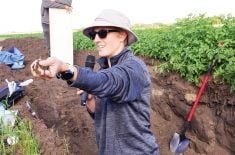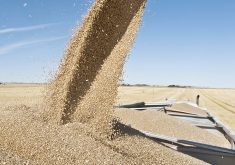Alberta’s honey production was well below average this year because of the cold spring and dry conditions in the province’s honey heartland, the northwest and Peace River regions.
Alberta beekeepers produced 105 to 110 pounds per hive this year, less than the provincial long-term average of 140 lb. per hive, said provincial apiculturist Medhat Nasr.
The good news for Alberta’s honey industry, and for beekeepers across the Prairies, is that prices are strong.
According to statistics from the U.S. National Honey Board, the average price of import honey is $1.40 US per lb., nearly double the October 2007 price and 40 cents more than last year at this time.
Read Also

Soybean market still figuring out implications of China-U.S. pact
Soybean futures had a muted reaction to the U.S. trade deal with China as the market tries to figure out the nuances of the deal.
“The market is strengthening and it’s likely to strengthen even more,” said Ron Phipps, a honey broker and president of CPNA International, who writes honey market reports for the American Bee Journal and other industry publications.
The price for white honey is $1.40 to $1.50 per lb., Phipps said. The price is higher for fine clover honey.
In a Sept. 17 speech at Apimondia, an international congress on beekeeping held this year in southern France, Phipps highlighted the factors behind the rise in honey prices.
In the last decade, drought, disease and colony collapse disorder have drastically cut U.S. honey production. In 2000, U.S. beekeepers produced 100,000 tonnes of honey. By 2008 that number had dropped to 73,000 tonnes.
Along with the decline in American production, Phipps estimated the 2009 Canadian harvest at 20,500 tonnes, approximately 65 percent of the 2007 total.
Honey production in Argentina, one of the world’s biggest exporters, has also fallen, Phipps said. Production has dropped to an estimated 50,000 to 65,000 tonnes from a previous average of 100,000.
The drop in Argentina is partly due to drought, Phipps said, but also because of strategic shifts in agriculture.
“They’ve been seduced by, attracted to, the soaring prices of soybeans. They converted a lot of pasture land into soybean and wheat production, neither of which produce a honey crop.”
Strong prices may help offset the reduced production in northwest Alberta and the Peace River.
In a typical year, beekeepers in that region produce 200 lb. per hive, Nasr said, but the cold spring and dry conditions resulted in a 25 percent drop in per hive production.
For Ian Steppler, a beekeeper near Miami, Man., 2009 was a memorable year for honey production.
The long winter and cold spring destroyed nearly 40 percent of his bees, but his colonies recovered thanks to a slow start to the growing season.
“When the weather smartened up, the bees, they started performing pretty well and I was able to make up a lot of losses,” said Steppler, who had 600 hives in production this year.
“With the staggered canola crop, they pulled honey right from the middle of July to almost September. (It was) a funny year, but it turned out all right.”
Overall, Steppler’s bees produced 175 lb. of honey per hive this year, higher than the Manitoba average of 165 lb.
Across the province, most beekeepers had a similar year, said Rheal Lafreniere, the provincial apiarist.
“The preliminary average honey production per hive was estimated to be 177 (lb. per hive),” Lafreniere said in an e-mail. Numbers could change as more data is collected from the eastern half of Manitoba, which was extremely wet this spring.
Lafreniere said Manitoba honey production would be down in 2009 compared to 2008 because of significant bee losses over the winter and spring.
In Saskatchewan, results of this year’s honey harvest won’t be known until later this month.
John Gruszka, the provincial apiculturist, said honey production could be down 25 percent in certain areas. Saskatchewan’s average production is about 195 lb. per hive.















